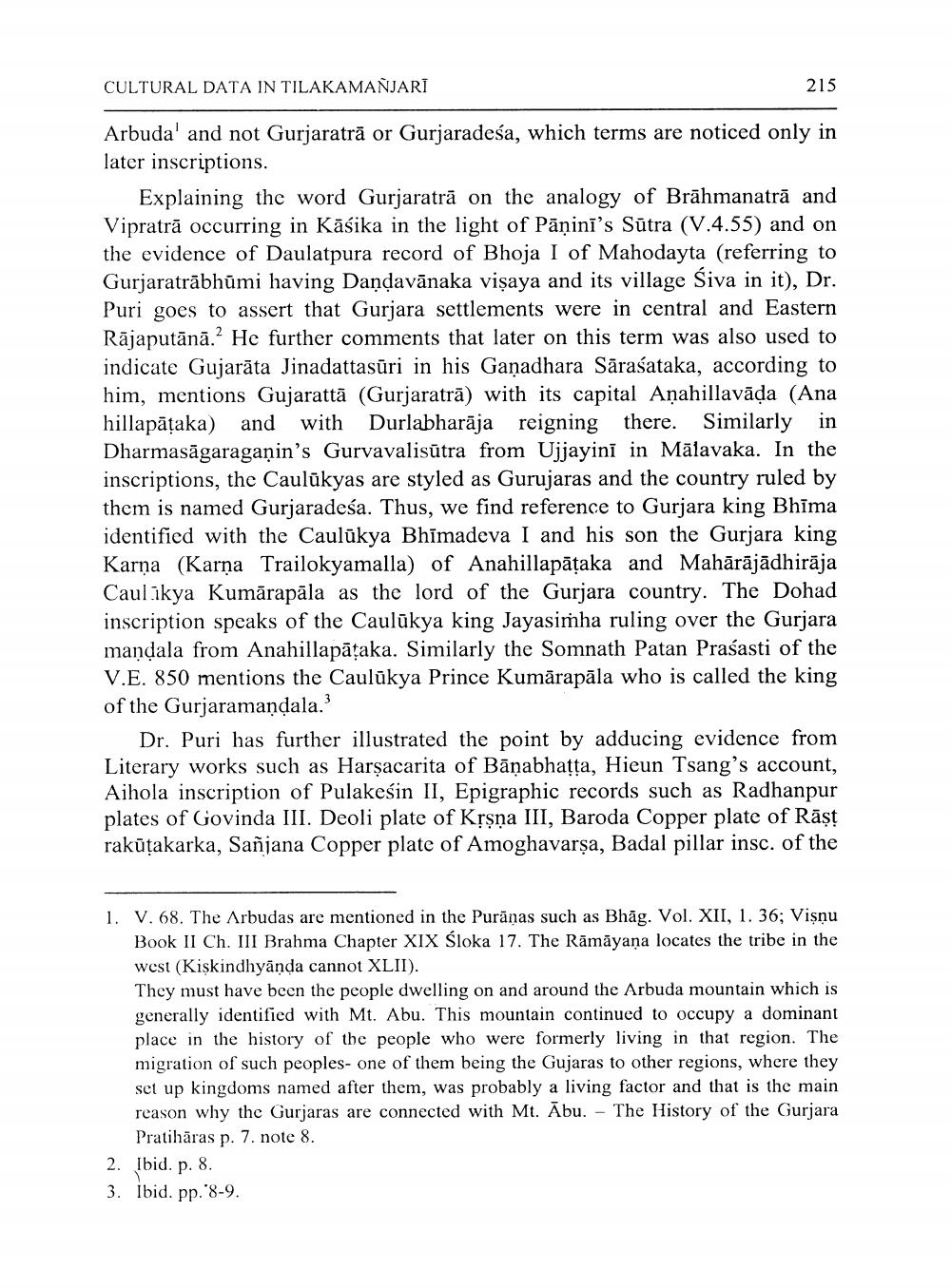________________
CULTURAL DATA IN TILAKAMANJARĪ
215
Arbuda' and not Gurjaratrā or Gurjaradeśa, which terms are noticed only in later inscriptions.
Explaining the word Gurjaratrā on the analogy of Brāhmanatrā and Vipratrā occurring in Kāśika in the light of Pāņinī's Sūtra (V.4.55) and on the evidence of Daulatpura record of Bhoja I of Mahodayta (referring to Gurjaratrābhūmi having Dandavānaka visaya and its village Siva in it), Dr. Puri goes to assert that Gurjara settlements were in central and Eastern Rājaputānā.? He further comments that later on this term was also used to indicate Gujarāta Jinadattasūri in his Gañadhara Sāraśataka, according to him, mentions Gujarattā (Gurjaratrā) with its capital Anahillavāda (Ana hillapāțaka) and with Durlabharāja reigning there. Similarly in Dharmasāgaraganin's Gurvavalisūtra from Ujjayini in Mälavaka. In the inscriptions, the Caulūkyas are styled as Gurujaras and the country ruled by them is named Gurjaradeśa. Thus, we find reference to Gurjara king Bhīma identified with the Caulūkya Bhimadeva I and his son the Gurjara king Karņa (Karņa Trailokyamalla) of Anahillapāțaka and Mahārājādhirāja Caulikya Kumārapāla as the lord of the Gurjara country. The Dohad inscription speaks of the Caulūkya king Jayasimha ruling over the Gurjara mandala from Anahillapāțaka. Similarly the Somnath Patan Prasasti of the V.E. 850 mentions the Caulūkya Prince Kumārapāla who is called the king of the Gurjaramandala."
Dr. Puri has further illustrated the point by adducing evidence from Literary works such as Harsacarita of Bānabhatta, Hieun Tsang's account, Aihola inscription of Pulakesin II, Epigraphic records such as Radhanpur plates of Govinda III. Deoli plate of Krsna III, Baroda Copper plate of Rāst rakūțakarka, Sañjana Copper plate of Amoghavarşa, Badal pillar insc. of the
1. V. 68. The Arbudas are mentioned in the Purānas such as Bhāg. Vol. XII, 1. 36; Vişnu
Book II Ch. III Brahma Chapter XIX Sloka 17. The Rāmāyaṇa locates the tribe in the west (Kiskindhyānda cannot XLII). They must have been the people dwelling on and around the Arbuda mountain which is generally identified with Mt. Abu. This mountain continued to occupy a dominant place in the history of the people who were formerly living in that region. The migration of such peoples- one of them being the Gujaras to other regions, where they set up kingdoms named after them, was probably a living factor and that is the main reason why the Gurjaras are connected with Mt. Ābu. - The History of the Gurjara
Pratihäras p. 7. note 8. 2. Ibid. p. 8. 3. ibid. pp. 8-9.




